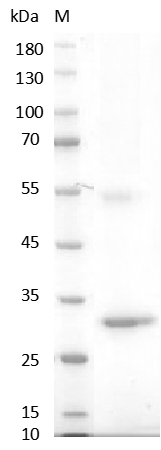| Product name | Human Noggin Protein, His tag |
| Sequence | Amino acid sequence derived from Human NOG (Q13253) (Gln28-Cys232) was expressed. |
| Applications | His-tag |
| Applications notes | Human |
| Activity | Testing in progress |
| Protein length | The recombinant Human NOG Protein consists of 206 amino acids and predicts a molecular mass of 23.2 kDa. |
| Preparation method | E.coli |
| Purity | > 98 % as determined by SDS-PAGE |
| Molecular Formula | 23.2 KDa |
| Alternative | Nog |
| Formulation | Lyophilized from sterile 20 mM Tris, 50 mM NaCl, pH8.0. |
| Features & Benefits | < 0.1 EU per μg of the protein as determined by the LAL method. |
| Molecular weight | 23.2 KDa |
| Usage notes | Always centrifuge tubes before opening. It is recommended to reconstitute the lyophilized protein using the buffer we provided not less than 100 µg/ml, which can then be further diluted to other aqueous solutions. |
| Storage instructions | Lyophilized protein product should be stored desiccated below -20°C. Upon reconstitution, the protein should be stored at 4°C between 2-7 days and for future use below -18°C. For long term storage |
| Shipping | Gel pack with blue ice. |
| Precautions | The product listed herein is for research use only and is not intended for use in human or clinical diagnosis. Suggested applications of our products are not recommendations to use our products in violation of any patent or as a license. We cannot be responsible for patent infringements or other violations that may occur with the use of this product. |
| Background | The secreted polypeptide Noggin, encoded by the Noggin gene, binds and inactivates members of the transforming growth factor-beta (TGF-beta) superfamily signaling proteins, such as bone morphogenetic protein-4 (BMP4). By diffusing through extracellular matrices more efficiently than members of the TGF-beta superfamily, Noggin may have a principal role in creating morphogenic gradients. Noggin appears to have pleiotropic effect, both early in development as well as in later stages. It was originally isolated from Xenopus based on its ability to restore normal dorsal-ventral body axis in embryos that had been artificially ventralized by UV treatment. The results of the mouse knockout of Noggin suggest that it is involved in numerous developmental processes, such as neural tube fusion and joint formation. Recently, several dominant human Noggin mutations in unrelated families with proximal symphalangism (SYM1) and multiple synostoses syndrome (SYNS1) were identified; both SYM1 and SYNS1 have multiple joint fusion as their principal feature, and map to the same region (17q22) as Noggin. All Noggin mutations altered evolutionarily conserved amino acid residues. The amino acid sequence of human Noggin is highly homologous to that of Xenopus, rat and mouse. |
| Gene ID | 9241 |
| Alternative | Nog |
| Accession | Q13253 |

You must be logged in to post a review.
1.The species of antibody reactivity should be the sample species that can be matched normally after Abbkine R&D experts have passed strict scientific verification. If your sample is not within the range of reactivity, in order to improve the efficiency and results of your experiment, it is not suggested to try other species. Otherwise, it may lead to sample mismatch and affect the effect of your experiment.
2.Please aliquot the antibody received as soon as possible and store it at -20℃, avoid repeated freezing and thawing, and use it within one year.
Welcome any form of communications, and better service will be provided here.
Tell: +1-404-854-0155
Email: service@abbkine.com
Support Email: support@abbkine.com
Address: 3052 Stroop Hill Road, Apt 203, Atlanta 30303, Georgia, United States of America




Reviews
There are no reviews yet.